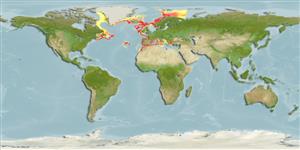Preferred temperature (Ref.
115969): 2.1 - 14.1, mean 6.3 (based on 199 cells).
Phylogenetic diversity index (Ref.
82804): PD
50 = 0.6250 [Uniqueness, from 0.5 = low to 2.0 = high].
Bayesian length-weight: a=0.00302 (0.00169 - 0.00538), b=3.03 (2.87 - 3.19), in cm Total Length, based on LWR estimates for this species & (Sub)family-body (Ref.
93245).
Niveau trophique (Ref.
69278): 4.5 ±0.6 se; based on diet studies.
Résilience (Ref.
120179): Faible, temps minimum de doublement de population : 4,5 à 14 années (K=0.13-0.16; tm=8-11; tmax=20).
Prior r = 0.31, 95% CL = 0.20 - 0.46, Based on 3 full stock assessments.
Fishing Vulnerability (Ref.
59153): Very high vulnerability (75 of 100).
Climate Vulnerability (Ref.
125649): Moderate to high vulnerability (47 of 100).
